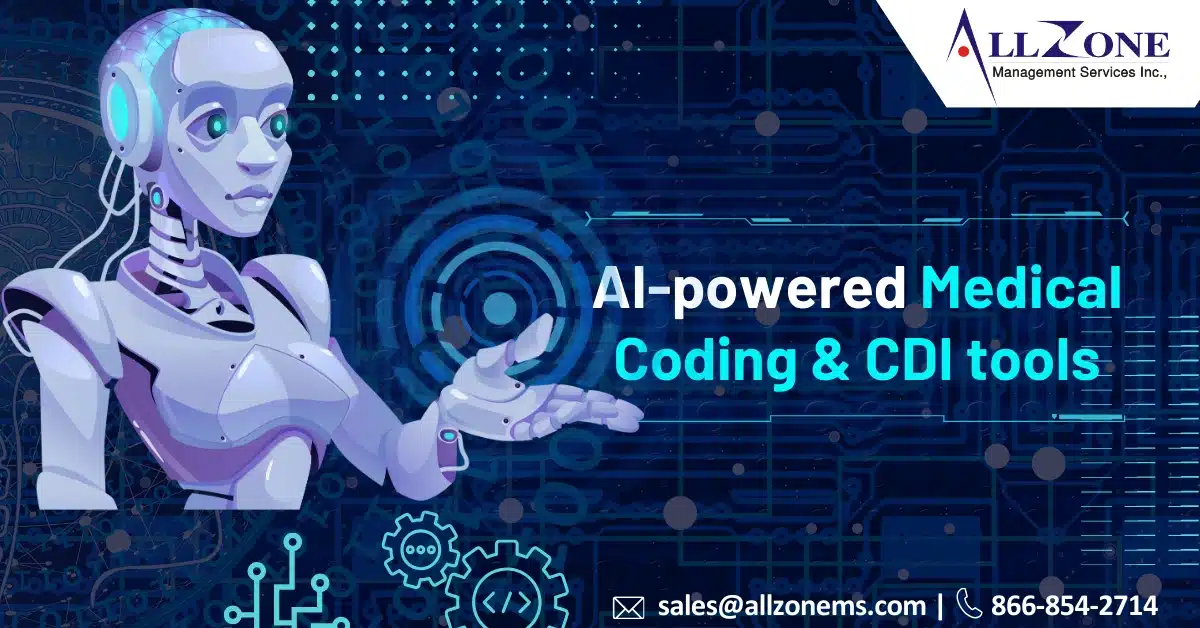Unlocking the Power of AI: Essential Features for Medical Coding and CDI Tools:
When choosing an AI tool to improve medical coding or clinical documentation integrity (CDI), healthcare organizations navigate a complex landscape of emerging technologies. To ensure the right selection, focus on key features that enhance accuracy, efficiency, and compliance.
One crucial aspect is the underlying AI technology. Generative AI stands out by actively assisting in clinical documentation creation. Unlike traditional AI, which analyzes data, generative AI can suggest entire sections of missing or under-detailed documentation based on physician notes and patient information. This goes beyond code selection, guiding clinicians toward more comprehensive real-time documentation, potentially increasing accuracy and reimbursement. It’s like having a digital assistant within your clinical workflow, continuously refining the documentation process
Beyond Codes: AI-Powered Solutions for Comprehensive SDoH and Clinical Documentation
Generative AI is also essential for enhancing social determinants of health (SDoH) documentation workflows. Unlike many AI tools that neglect SDoH, a high-quality tool can detect missing SDoH details and prompt users for inclusion. This ensures more holistic and accurate coding, impacting risk adjustment and quality scores.
In addition to generative AI, natural language processing (NLP) is crucial for medical coding and CDI. The NLP engine’s ability to comprehend clinical language, regardless of source (typed notes, dictated text, or voice-to-text), is a significant advantage
Intelligent Predictions: Leveraging AI for Proactive Documentation and Coding
A robust NLP system can process complex clinical narratives, decipher abbreviations, and interpret diverse medical terminologies. This ensures that the AI can understand variations in provider language without missing critical information or generating errors.
Consider the NLP engine’s capabilities. Can it integrate seamlessly with your EHR and function across various specialties?
Predictive analytics is another game-changing feature. This AI uses historical and real-time data to predict potential documentation issues or coding errors proactively. For example, if a code is associated with denials, predictive analytics can flag it early, allowing for corrections before billing. This saves time and money by reducing claim rework and denials. Additionally, predictive AI can identify documentation gaps that may impact CMS star ratings or hospital value-based purchasing performance
Enhancing Medical Coding with Machine Learning and Conversational AI
Machine learning is another critical component of a high-quality AI tool. Its ability to learn from experience is essential for continuous improvement. As the AI processes more clinical data and interacts with users, it can refine its recommendations and become more accurate. This adaptability is crucial for keeping up with frequent ICD and CPT code updates.
Conversational AI is often overlooked but can significantly enhance user experience. This feature allows clinicians to interact with the AI tool using voice commands or interactive prompts. For busy clinicians, especially in outpatient settings or emergency departments, verbal documentation can save time. A conversational AI tool can process natural language and offer real-time assistance, improving documentation quality and reducing clinician workload. This leads to a win-win situation, reducing burnout while increasing accuracy.
Beyond Basic Reporting: Harnessing AI for Actionable Insights
AI tools should offer more than just basic reporting. They need to provide actionable insights that help you track and measure key performance indicators (KPIs) relevant to your organization. Ask yourself: Can the tool give you a detailed view of documentation trends? Can it identify areas that need additional training or support? Is it customizable to meet your specific needs for compliance, revenue integrity, and clinical outcomes? The more transparent and customizable the analytics, the better you can optimize your CDI efforts.
When choosing an AI tool, consider scalability and vendor support. Ensure the solution can grow with your organization. Look for vendors that offer ongoing education, support, and updates. A successful partnership involves more than just technology; it’s about working with a vendor committed to your long-term success
Enhancing Medical Coding and CDI with Allzone MS
A comprehensive suite of tools designed to streamline medical coding and clinical documentation improvement (CDI) processes. By incorporating Allzone MS into your medical coding company, you can significantly enhance efficiency, accuracy, and compliance.
Key Features of Allzone MS:
- Automated Coding: Allzone MS utilizes advanced algorithms to automatically assign codes based on clinical documentation, reducing manual effort and increasing efficiency.
- Natural Language Processing (NLP): The tool’s NLP capabilities allow it to accurately interpret and understand clinical notes, ensuring that codes are assigned correctly.
- Clinical Documentation Improvement (CDI): Allzone MS provides tools to help CDI specialists identify and address documentation gaps, ensuring that clinical records are complete and accurate.
- Compliance Tracking: The software helps monitor compliance with coding guidelines and regulations, reducing the risk of audits and penalties.
- Integration with EHRs: Allzone MS can seamlessly integrate with your existing electronic health records (EHRs), streamlining workflows and minimizing data entry errors.
Implementing Allzone MS:
- Assessment and Training: Conduct a thorough assessment of your current processes to identify areas where Allzone MS can provide the most benefit. Train your staff on how to effectively use the software to maximize its potential.
- Workflow Integration: Integrate Allzone MS into your existing workflows, ensuring that it seamlessly complements your existing processes.
- Data Migration: If necessary, migrate relevant data from your existing systems to Allzone MS to ensure a smooth transition.
- Continuous Improvement: Regularly review and evaluate your use of Allzone MS to identify areas for improvement and optimize its effectiveness.
Benefits of Using Allzone MS:
- Increased Efficiency: Automation and streamlined workflows lead to significant time savings.
- Improved Accuracy: The software’s advanced algorithms help ensure accurate coding and documentation.
- Enhanced Compliance: Allzone MS helps maintain compliance with coding guidelines and regulations.
- Reduced Costs: By improving efficiency and reducing errors, Allzone MS can help lower operational costs.
- Better Patient Care: Accurate coding and documentation contribute to improved patient care and outcomes.
By leveraging Allzone MS, medical coding companies can optimize their operations, enhance accuracy, and ensure compliance with industry standards.

